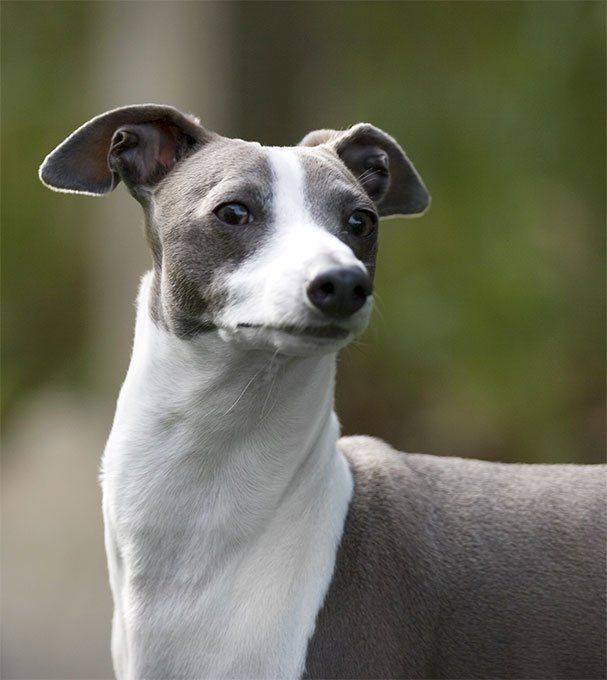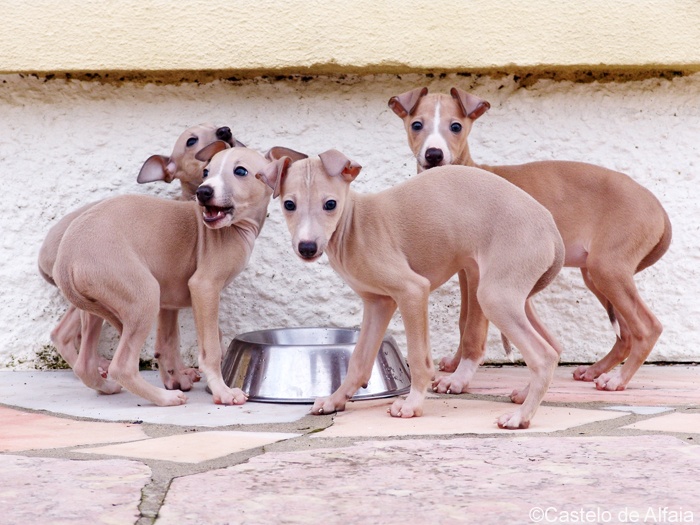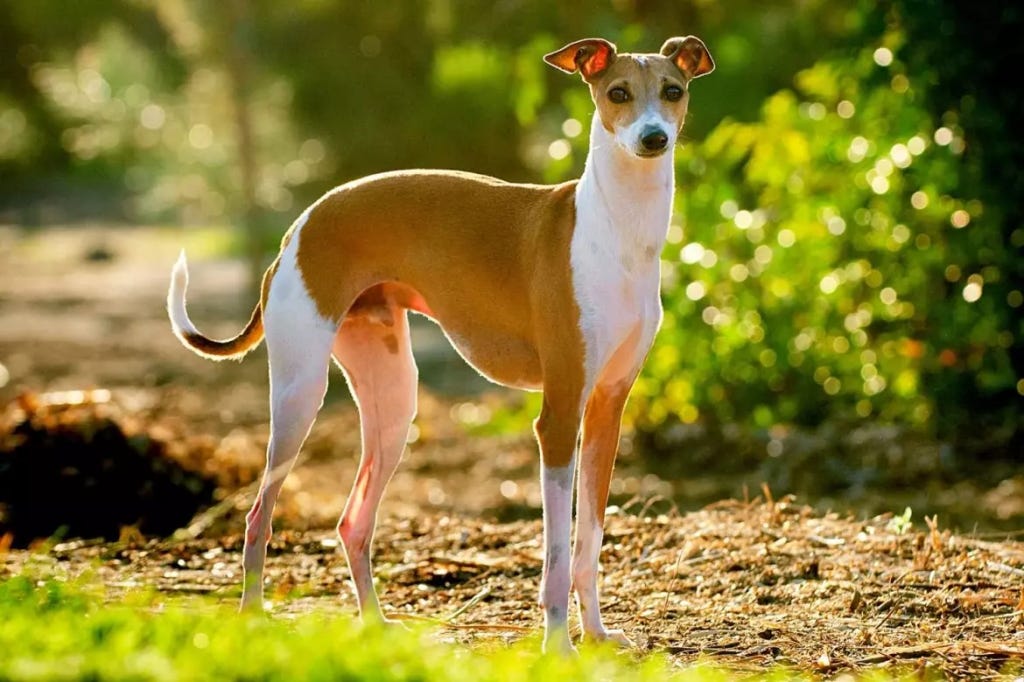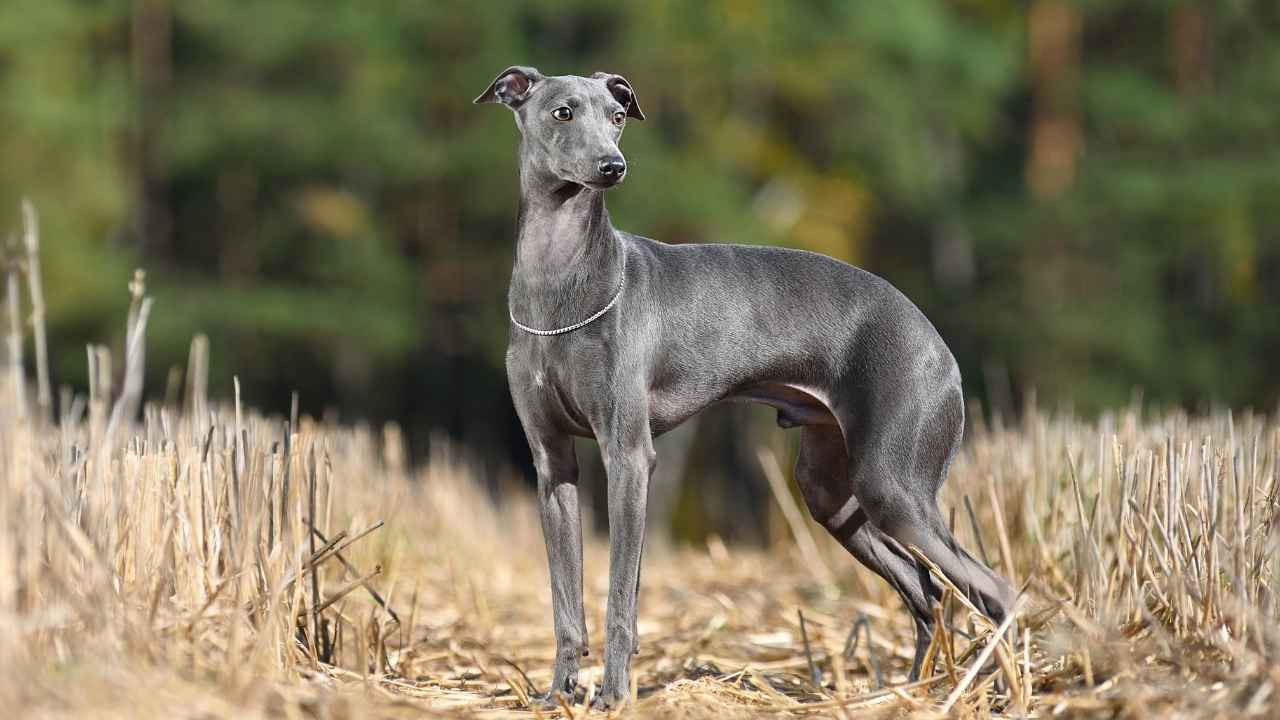The Italian Greyhound embodies graceful stature, winning owner affection with its refined curves, sweet disposition, and occasional racing spurt across the room. Yet how does it measure against the Whippet? Here’s the complete rundown before you decide which speedy companion to bring home. We tackle the following questions:
- Whippet compared to Italian Greyhound: side-by-side
- Do Italian Greyhounds tend to bark frequently?
- Are they hypoallergenic?
- How well do they coexist with cats?
- Price comparison, including Italian Greyhound costs
You’ll explore coat shades, mixed breeds, longevity, size, grooming, interaction with people, cute Italian Greyhound outfits, and more.
Whippet versus Italian Greyhound: Key Distinctions
Size and Build
- Italian Greyhounds, measuring 13 to 15 inches at the shoulder and weighing 7 to 14 pounds, sport a dainty, almost ethereal frame.
- Whippets, on the other hand, stand 18 to 22 inches tall and tip the scales at 25 to 40 pounds, boasting a sturdier, more athletic body.
Both breeds show classic sighthound grace, yet prospective owners weighing whippet against Italian Greyhound and greyhound should factor in different appetites, activity demands, and room needed indoors.
Energy & Temperament
- Italian Greyhounds are affectionate, slightly dramatic, and frequently dubbed “velcro dogs” for good reason; they keep close and prefer quiet companionship. Their hearts are big, and so are their needs for gentle, non-stressful environments.
- Whippets are a little cooler and breezier, perfectly at home in a busy household eager for a daily jog. Both are born for speed, though the IG will happily settle for a few happy dashes, then curl up for a long, blissful nap.
Do Italian Greyhounds Bark a Lot?
Italian Greyhounds are generally quiet dogs, thanks in part to their sleek coats and easy temper. A few barks might alert you or reveal their uncertainty about a sudden noise. Some may chatter briefly when left alone, a little quirk of nerves.
The good news is that socializing early, combining companionship with gentle training, usually quiets the chatter. So when asked whether Italian Greyhounds bark a lot, the phylogenetic answer is “no”—but like all things dog, one or two will happily prove the exception.
Are Italian Greyhounds Hypoallergenic?
Italian Greyhounds rank high among breeds easy on allergy-sensitive noses. Their coats are short and close, and that primary fur produces minimal dander.
They shed so little that a swift rub with a damp cloth every few days is usually enough; a rare, mild bath now and then takes care of remaining stray particles. So while not completely allergy-proof, Italian Greyhounds often feel at home in sneezeless households.
Are Italian Greyhounds Good with Cats?
More often than not, yes; when a confident, calm cat meets a gentle IG raised together or properly introduced, they usually settle into a cordial truce. The dog may occasionally chase a fast-moving tail, but a quiet hiss usually reminds him of his manners.
A calm household with several pets relies on a couple of guiding ideas:
- Socialization matters a lot; gentle, varied experiences while they’re young lay the groundwork for friendly coexistence.
- When introducing the animals, take your time; the brisk energy of an IG might start a small-dog or cat chase based on pure curiosity.
- Close watch stays necessary, particularly if a kitty isn’t used to the sight of a fast, slight dog sprinting through the space.
Once they settle in together, trust grows; IGs curled up with cats on the sofa or windowsill is a sight that leads many to ask, “Are Italian Greyhounds good with cats?” The answer is typically a bright yes, especially with that picture in mind.
Italian Greyhound Colors, Varieties, and Mixes
Available Coat Colors
Italian Greyhound coat colors include:
- Fawn, cream, black, red, blue (popular among blue Italian Greyhound enthusiasts)
- Chocolate, slate grey, tan, seal, and sable
- Some dogs have white markings on chest, paws, or tail
Mixes & Hybrids
While purebred Italian Greyhound is the most common type, designer crosses exist:
- Italian Greyhound × Chihuahua
- Italian Greyhound × Dachshund
- Italian Greyhound × Whippet – known for height and athletic ability
- Each mix retains some Italian Greyhound traits: slender frame, loyalty, and speed—but with variations in coat, size, and personality

Health, Age, and Lifespan
A well-loved Italian Greyhound joins the family for 12 to 15 years, with many happily clocking in at over 14 when treated with care and affection.
Common Health Issues
- Puppies have delicate bones and are prone to leg fractures.
- Gums can develop tartar and gum disease.
- The patella (kneecap) can slip out of place in small breeds.
- Progressive Retinal Atrophy (PRA) causes gradual vision loss.
- Skin needs moisture and can become dry and irritated.
Keeping Italian Greyhounds healthy means light exercise, a gentle environment, regular checkups, and good dental hygiene.
Size, Physical Traits & Ideal Environment
- Ideal height is 13 to 15 inches, weighing 7 to 14 pounds.
- They are tall, slender, and have a single short, smooth coat.
These dogs thrive in apartments or quiet homes, with soft, warm bedding. Agile but not sturdy, they shouldn’t be in rough play or chilly air. They do best kept indoors with other dogs or caring owners close by.
Italian Greyhound Cost: How Much Is a Greyhound Dog?
- Puppies from responsible breeders cost $1,200 to $3,000, depending on lineage and color. Rare shades like slate or chocolate may be more.
- Rescue dogs from breed-specific groups range from $150 to $400, and fees often cover health checks and sterilization.
- Whippet, Greyhound, and Italian Greyhound rescue groups frequently provide retired racers or retired show dogs for adoption at reasonable fees.
- Budget for recurring costs such as high-quality kibble, yearly vet visits, preventative medicines, grooming supplies, basic obedience classes, and that extra layer of Italian Greyhound jackets or little booties to keep them toasty indoors.

Grooming Needs and Clothing for Italian Greyhounds
Italian Greyhounds have minimal grooming requirements:
- Weekly gentle brushing to remove dead hair
- Bathing every few months or as needed
- Nail trims every few weeks
- Routine dental cleaning and ear checks
Because their fine coat offers little insulation, they benefit significantly from caring garments:
- Italian Greyhound sweaters, coats, hoodies, and rain jackets keep them warm and snug
- Dog clothes Italian Greyhound owners love include fleece-lined sweaters, snug-fitting hoodies, and seasonal outfits
- Investing in Italian Greyhound clothes also helps reduce anxiety and shivering in colder climates
Temperament, Training & Aggressiveness
Italian Greyhounds are affectionate, calm, and gentle:
- Known for being non-aggressive, even shy around strangers
- Bond tightly with one or two caregivers
- Prone to separation anxiety; a second quiet dog companion can help
- Respond best to gentle training—harsh corrections may stress them
Proper early socialization helps them flourish around different people, pets, and environments. Kids should be taught to handle them carefully due to their fine bone structure.
Italian Greyhound & Social Life
With People
- Italian Greyhounds love hugs, laps, and shared warmth. They may follow you room to room, eager to stay close.
- They require an owner presence or nonstop companionship, making them ideal for remote workers or calm households.
With Other Pets
- Cats: Calm coexistence often develops with careful introduction.
- Other dogs: Gentler or same-sized dogs are best playmates. High-energy or large-breed dogs can unintentionally hurt them.
- Small animals: Supervise interactions to prevent chasing or roughness.
Italian Greyhound Clothing & Puppy Apparel Trends
Owners embrace dressing their IGs year-round to support their health and style:
- Brands produce Italian Greyhound sweaters, rain jackets, and winter coats tailored for sleek bodies.
- Many shops highlight Italian Greyhound clothing, including durable everyday wear and holiday costumes.
- Puppy owners may look for Italian Greyhound clothes for sale near me—online shops now offer sizing precise for the breed’s measurements.
Wearing clothes helps with warmth and can also reduce anxiety in IGs sensitive to change or cold.
Caring for Italian Greyhounds: Quick Tips
- Make a cushioned, snug area at home and give them soft, warm bedding.
- In chilly months, dress them in Italian Greyhound sweaters to keep them cozy.
- Choose a harness for walks to keep their neck safe without strain.
- Gentle games in safe spaces keep their long, delicate legs protected from injury.
- Schedule regular vet visits and keep up with dental care to support their long life.
- If you have other pets, introduce them slowly and supervise until all are happy together.
Final Thoughts
Whether you’re deciding between a Whippet and an Italian Greyhound, curious about their barking, or wondering what one might cost, the Italian Greyhound stands out for graceful companionship cloaked in loyalty and quiet charm. Their small size, minimal shedding, and sweet temper make them a perfect match for those seeking a stylish, loving friend—plus charming Italian Greyhound sweaters, custom shirts, and puppy gear you can’t resist.
With careful attention, steady training, and lots of love, Italian Greyhounds enjoy long, joyful lives, often surprising owners with bursts of speed, spilling affection, and lazy afternoons curled at their feet.


